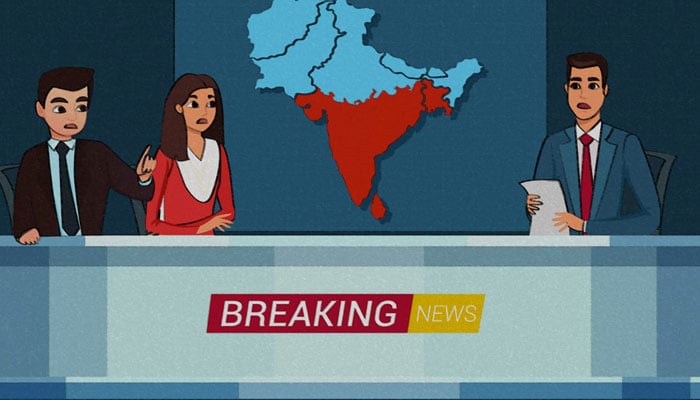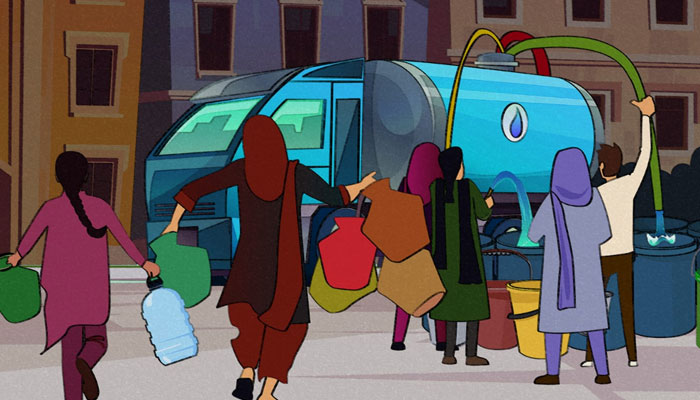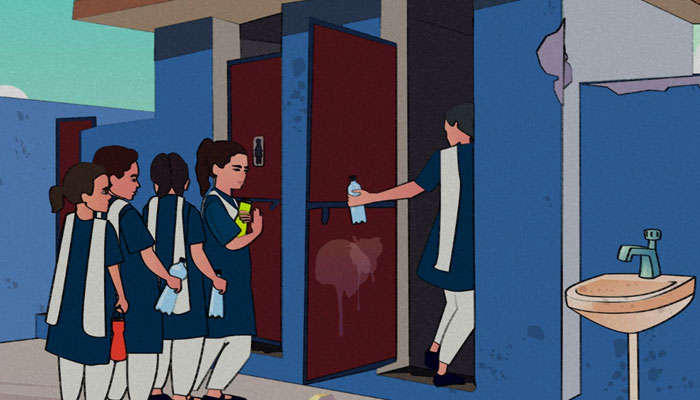India’s Dams and Pakistan’s Water Crisis
Pakistan is being strangled by a chronic water shortage that stands to exacerbate tensions with India
October 17, 2022

KARACHI: Thirteen-year-old Kaneez Sughra, a resident of Pakistan’s Orangi town near Karachi, has a strange problem. Every day, before coming to school, she has a choice to make about what is more important: her education or the stored water at her home?
“All the taps in my school are dry. Even when I go to the school toilet, I use the water that I bring from my home,” Sughra said while waiting for her turn at the school’s only toilet, holding a water bottle.
The dry taps do croak back to life sometimes, but the water from them remains unusable as it is either dirty or has a foul odour. The school administration attempted to dig a well within the school premises but the water in the well was yellow and salty.
“It can be used to flush the toilet but it cannot be consumed,” said the teenager.
Sughra’s case is just one example of how Pakistan is struggling to provide water for its residents. According to a report published by the Pakistan Institute of Development Economics (PIDE) this year, more than 80% of Pakistanis face “severe water scarcity” for at least one month each year. The report stated that Pakistan ranks 14 out of 17 countries designated as “extremely high water-risk” nations.
The situation has geopolitical significance due to Pakistan’s status as India’s lower riparian country. Pakistan receives over 78% of India’s water inflows.
Along with the crisis posed by rivers and streams running dry, Pakistan’s dangerously depleted groundwater levels have left most parts of the country parched. If present trends persist, the entire country may face “water scarcity” by 2025, states the PIDE report.
Pakistanis are already feeling the effects. Women, whose problems are frequently overlooked in Pakistan, are severely affected by the water crisis. It has a dangerous impact on their menstrual hygiene, impacting the education of young girls. For instance, Sughra and her friends said they struggle on most days, but that it is the worst during their periods.
“I make excuses at home because I don’t want to go to school. We miss homework and classes and are punished for it the following day,” the Orangi teenager said, pointing to a group of girls standing outside one of the classrooms. “Our teacher asks us to leave the classroom and stand outside.”
Sughra, who wants to study computers, is not hopeful about her future at her school. “I want to attend a better school where we have water. It would make coming to school easier,” she said.

Her school principal, Munira Kazmi, said that the management had done everything in their capacity to help the students.
“The problem is not limited to this school. Our locality witnesses water shortage for weeks. People pay for water tankers, which are expensive. Purchasing a water tanker every week is not sustainable for a small school like ours,” said Kazmi.
According to the informal rate chart, one tanker containing nearly 4,000 gallons of water lasts a week and costs around 6,000-7,000 Pakistani rupees. With Pakistan’s per capita income standing at around 340,590 rupees and 39.3 percent of people below the poverty line as per the 2020-21 data, not many families can pay around 28,000 rupees per month for water.
'No water at all'
The water scarcity crisis in Pakistan has spared none. Along with the low-income groups, the rich and elite too struggle with the problem. A posh neighbourhood in Karachi is a great example.
A little over a decade ago, Karachi-based banker Zafar Ahmed, 45, grew vegetables at his 1,000-sq-ft home in the upscale neighbourhood of Defence Housing Authority, more popularly known as DHA. “We grew spinach, lettuce, brinjals, and capsicums at home, but had to stop due to scarcity of water. The kitchen garden, where we once grew fruits and vegetables, has now been converted to a car parking space,” said Ahmed. He that artificial grass and cement tiles have replaced his lush gardens.
Ahmed said that some areas in DHA receive no water at all. The area is regularly in the news due to concerns over its severe water crisis. “We pay nearly 50,000 rupees per month to arrange water tankers here. There is an additional cost for drinking water bottles as the water in tankers is unsuitable for consumption,” Ahmed said.
“With rising prices of electricity, petrol and gas, the price of water tankers has also shot up over the years and shows no signs of slowing down. There seems to be no end to this crisis,” he added.
Why is water vanishing?
Some academic experts blame the water crisis on a 60-year-old water-sharing deal with India. They believe that former Pakistani regimes struck a deal with India and “sold the rivers,” thereby depriving Pakistan of water over the long term.
Mohammad Obhayo Khushk, who has authored several books on hydro-politics in Pakistan, said, “Ravi, Sutlej, and Beas [rivers] were sold to India under Indus Basin Treaty 1960. It was a mistake made by the past leaders which cost the future generations a lot.”

Khushk, who has also served as a civil engineer in the Sindh irrigation department, said, “As per the Indus Delta Treaty, signed before the Indus Basin Treaty 1960, Pakistan was getting 73 million acre-feet of water, after which the flow of water minimized and now the Delta mostly runs dry.”
Talking about Sindh, a southern province of Pakistan and lower riparian region, Khushk stated that the area suffered a significant blow this year. “The Kharif crop (sown in summer and harvested in late summer or early autumn) is sowed in May. But the rivers dried up in May as the upper riparian region of Punjab received the water first. Sindh did not get water until July, which had a devastating impact on the rice harvest,” he explained.
Climate change has also worsened the problem in the region. Since the Indus Delta relies heavily on glaciers, which are now melting, Pakistan is being pushed toward a serious water crisis in the form of droughts.
Talking about the economic impact of water shortage, Khushk said, “The cultivation field that receives water from the Kotri barrage in Sindh is 36 lakh (3.6 million) acres. However, it could only produce 20-25% of the harvest this year.”
Along with India, Afghanistan is also planning to build a dam on the Kabul River system. Khushk said that once these dams are built, it will further aggravate the water crisis in Pakistan.
While battling an acute water shortage crisis, most Pakistani politicians, government-backed experts, and the public blame India for the crisis. The scars of a brutal partition in 1947 and subsequent wars have led to a fragile relationship between the two countries.
“Whenever India turns off the water tap, Pakistan faces scarcity of water supply,” said Kauser Khan, 30, a resident of south Punjab’s Malisi city. The family earns their living through farming on their land and selling the produce in nearby markets.
Reiterating Kauser’s concerns, her husband Hayat Khan, 42, said, “The Indian water atrocities could have a negative impact on crops, forcing farmers to draw water from tube wells. This increases the cost of agricultural cultivation and reduces our income.”

Experts said that the public perception of India’s role in the water crisis is propelled by hyper-nationalist Pakistani media outlets. “Right-wing Urdu media in Pakistan use international geopolitical rhetoric to portray Pakistani floods as the result of flood-season water flow into Pakistan by Indian water management,” said Dr. Daanish Mustafa, a professor in the Department of Geography at King’s College, London.
Mustafa said that Pakistani newspapers refer to this alleged “water aggression” strategy as “abee jarhiyyat” in their editorials. Pakistani media frequently repeats this rhetoric as it is aligned with their anti-India tone that focuses on portraying India as “the enemy who wants to destroy Pakistan.” But how much of it is based on truth?
Indo-Pak politics around dams
According to a report prepared by the international advocacy group, Climate Diplomacy, a leading independent think tank and public policy consultancy on climate issues, the Indus River system is nourished by glaciers and rivers that originate in the high mountains of the Ngari Province of western Tibet, the Himalayas, the Hindu Kush of Afghanistan, and the Karakoram.
Most of Pakistan’s population resides in the lowlands, which are also one of the largest agricultural regions in Asia. Agriculture and livestock farming supported by the Indus help sustain 90% of Pakistan’s food requirements and employ around 65% of its population, reports Wilson Center’s Environmental Change and Security Program.
According to research by Cambridge University’s Kyle Gardner, the Line of Control (LOC), which serves as the de-facto India-Pakistan border, was established and determined largely based on river courses in the highlands. The LOC divides India-controlled Jammu and Kashmir from Gilgit-Baltistan and Pakistan-controlled Azad Kashmir. Numerous river tributaries flow along the LOC, creating room for the “water aggression” theories.
According to a study done by Inamul Haq and Sheeraz Ahmad Sofi of Kabul University, Kashmir has always borne the brunt of the Pakistan-India conflict. India, as the upper riparian state, threatens Pakistan by preventing water from flowing through its territory. In 2019, India repealed Article 370 and incorporated Kashmir into Indian territory, as a result of political tensions, the water crisis was exacerbated for Pakistan. Water bodies in Kashmir have also not been adequately harnessed due to this political instability between the two countries.
India is hoping to change that. As detailed in part one of this series, India has ambitious plans to build seven new dams in the Kishtwar region of Indian-administered Kashmir. The construction is already impacting the lives of local Kashmiris; the long-term impact of the dams themselves will be felt across the border as well, potentially exacerbating India-Pakistan tensions.












